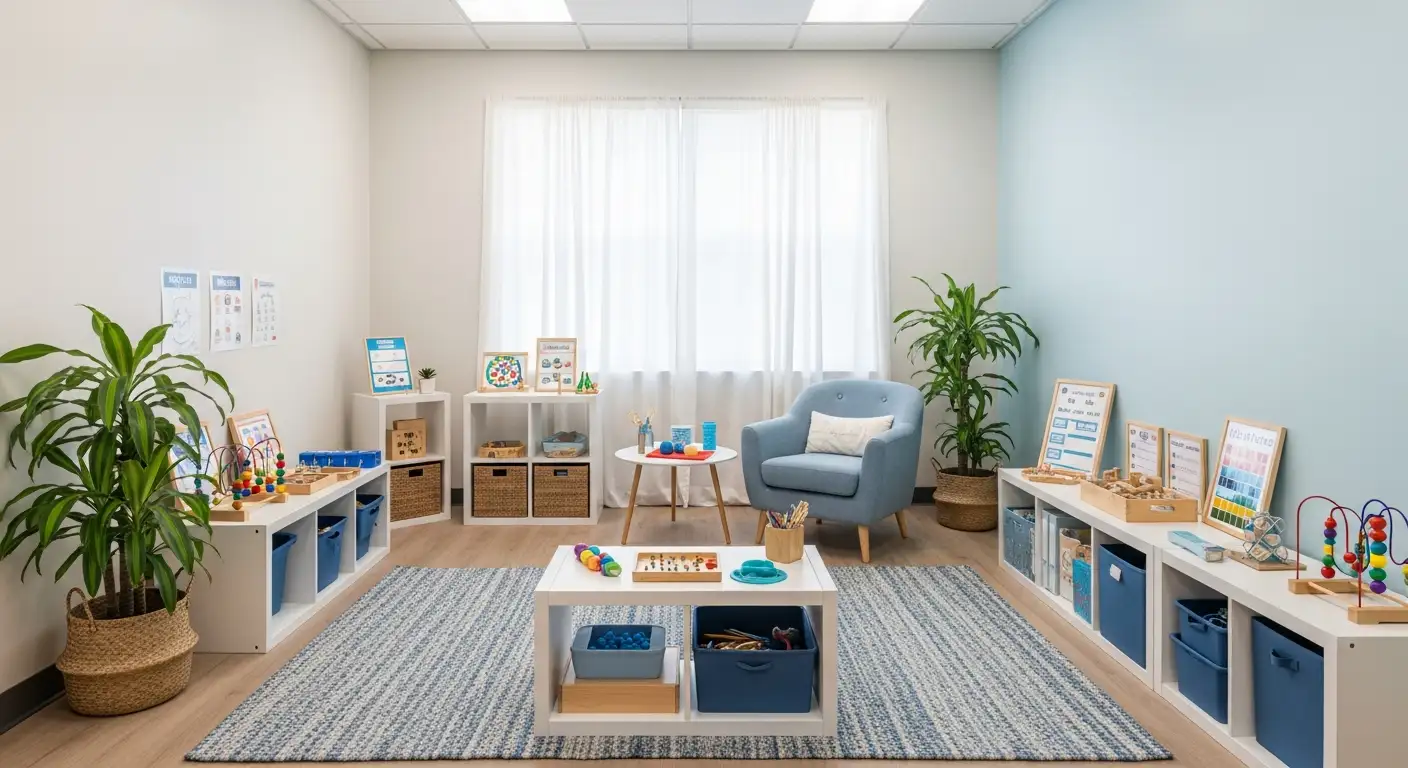Understanding ABA Therapy for ADHD

ABA therapy, endorsed by the Centers for Disease Control and Prevention (CDC), has emerged as a promising intervention for treating Attention Deficit Hyperactivity Disorder (ADHD). This section delves into the basics of ABA therapy and its effectiveness for children with ADHD.
The Basics of ABA Therapy
Applied Behavior Analysis (ABA) therapy focuses on helping children with ADHD learn new skills and reduce problem behaviors. This evidence-based approach uses principles of learning theory to bring about positive changes in behavior. ABA therapy emphasizes:
- Positive Reinforcement: Rewarding desired behaviors to encourage their recurrence.
- Structured Routines: Establishing clear, consistent routines to provide predictability and stability.
- Individualized Approaches: Tailoring interventions to meet the unique needs of each child.
ABA therapy involves breaking down tasks into manageable steps, utilizing visual aids, and employing systematic instruction to help children improve focus, organization, and time management skills. For more information on how ABA therapists implement these strategies, visit what do aba therapists do.
Effectiveness of ABA Therapy for ADHD
Numerous studies have shown that ABA therapy can be effective in treating ADHD in children. The key outcomes of ABA therapy include:
- Improved Social Skills: Enhancing interactions with peers and adults.
- Enhanced Adaptive Skills: Teaching practical skills for daily living.
- Reduced Problem Behaviors: Decreasing hyperactivity, inattention, and aggression.
A summary of the effectiveness of ABA therapy for ADHD is presented below:
These improvements can lead to significant enhancements in overall functioning and quality of life for children with ADHD. ABA therapy also plays a crucial role in decreasing impulsivity and hyperactivity, improving executive function, and involving parents and caregivers in the treatment process for consistent support. For more on how parents can get involved, check out aba therapy training for parents.
By understanding the basics and effectiveness of ABA therapy, parents and caregivers can make informed decisions about the best interventions for their children with ADHD. For those in New Jersey, exploring options for ABA therapy near me that accepts medicaid can provide accessible and effective support.
Benefits of ABA Therapy

Improving Social and Adaptive Skills
ABA therapy for ADHD emphasizes the development of social and adaptive skills, which are crucial for children to thrive in various environments. According to ABT Behavioral Analysis, numerous studies have shown that ABA (Applied Behavior Analysis) therapy can significantly improve social interactions and adaptive behaviors in children with ADHD. These improvements are achieved through structured routines and individualized strategies tailored to each child's needs.
Positive reinforcement techniques within ABA therapy have been particularly effective in fostering these skills. By consistently rewarding desired behaviors, such as focusing on a task or following instructions, children with ADHD can learn and generalize these skills to various settings and situations [2].
Reducing Problematic Behaviors
ABA therapy is also effective in reducing problematic behaviors associated with ADHD, such as hyperactivity, inattention, and aggression. According to ABT Behavioral Analysis, the use of positive reinforcement, structured routines, and individualized approaches can lead to significant reductions in these behaviors, ultimately improving the child's overall functioning and quality of life.
By focusing on reinforcing positive behaviors and discouraging negative ones, ABA therapy helps children with ADHD develop better self-control and attention. This approach not only addresses the immediate problematic behaviors but also equips the child with skills that can be generalized across different environments and situations.
For parents and caregivers looking to support their child's development, understanding what do ABA therapists do and how to access aba therapy near me that accepts medicaid can be incredibly beneficial. Additionally, aba therapy training for parents can provide valuable insights and techniques to reinforce positive behaviors and manage problematic ones effectively at home.
ABA Techniques for ADHD
Applied Behavior Analysis (ABA) therapy offers a range of techniques to support children with ADHD. Two primary methods include positive reinforcement strategies and structured routines with individualized approaches.
Positive Reinforcement Strategies
Positive reinforcement is a cornerstone of ABA therapy for ADHD. It involves rewarding desired behaviors to encourage their repetition. This method has been effective in improving attention, self-control, and task completion in children with ADHD.
By consistently rewarding behaviors such as focusing on a task or following instructions, children can learn and generalize these skills across different settings and situations.
For more information on how ABA therapists implement these strategies, visit what do aba therapists do.
Structured Routines and Individualized Approaches
Creating structured routines and individualized approaches is another key technique in ABA therapy for ADHD. This involves developing a predictable schedule and using visual aids to help children understand and follow their daily activities. By breaking down tasks into manageable steps, therapists can help children improve their focus, organization, and time management skills [3].
ABA therapy is flexible and can be tailored to address the specific needs of each child. Therapists work closely with individuals to develop personalized treatment plans targeting specific behaviors and challenges based on a thorough assessment of strengths and areas of need.
For parents interested in learning how to create these structured routines at home, check out aba therapy training for parents.
Using these techniques, ABA therapy helps children with ADHD learn new skills, improve social interactions, and reduce problem behaviors, ultimately leading to significant improvements in their overall functioning and quality of life. To find ABA services in your area, you can search for aba therapy near me that accepts medicaid.
Customizing ABA Therapy

ABA therapy for ADHD can be tailored to address the specific needs of children, making it a flexible and customizable intervention for improving behavioral and social skills.
Tailoring to Specific Needs
Tailoring ABA therapy to the specific needs of children with ADHD is essential for maximizing its effectiveness. Therapists work closely with individuals to develop personalized treatment plans targeting specific behaviors and challenges based on a thorough assessment of strengths and areas of need [2]. This approach allows the intervention to be highly adaptable, addressing unique issues such as impulsivity, hyperactivity, and difficulty with social interactions.
Some common strategies used in personalized ABA therapy plans include:
- Visual Aids: Utilizing visual schedules and charts to help children understand and follow routines.
- Task Breakdown: Breaking down complex tasks into smaller, manageable steps to make them less overwhelming.
- Positive Reinforcement: Providing immediate rewards for positive behaviors to encourage their repetition.
For more insights on how ABA therapy can be tailored to individual needs, visit our page on what are the needs of a person with autism.
Creating Structured Routines
Creating structured routines is another key component of effective ABA therapy for ADHD. Structured routines help children with ADHD improve their focus, organization, and time management skills. A consistent routine provides a predictable environment, which can reduce anxiety and improve compliance with daily tasks.
Key elements of structured routines in ABA therapy include:
- Consistency: Maintaining a consistent schedule for daily activities to create a sense of stability.
- Clear Expectations: Setting clear and concise expectations for each task or activity.
- Routine Reinforcement: Using reinforcement strategies to encourage adherence to the routine.
By incorporating these elements, therapists can help children with ADHD develop skills that are essential for daily functioning. For further details on how structured routines are implemented, explore our article on what do aba therapists do.
ABA therapy's adaptability and structured approach make it a valuable tool for supporting children with ADHD. For parents interested in learning more about ABA therapy and how to implement it at home, consider checking out our resources on aba therapy training for parents and finding aba therapy near me that accepts medicaid.
Role of ABA Therapy in ADHD Treatment
Applied Behavior Analysis (ABA) therapy is a valuable intervention for individuals with Attention Deficit Hyperactivity Disorder (ADHD). This therapy focuses on decreasing impulsivity and hyperactivity, as well as involving parents and caregivers in the treatment process.
Decreasing Impulsivity and Hyperactivity
ABA therapy employs various techniques to help manage and reduce the symptoms of ADHD. One of the primary goals is to decrease impulsivity and hyperactivity, which are hallmark characteristics of ADHD. Positive reinforcement techniques within ABA therapy have been effective in improving attention, self-control, and task completion in children with ADHD [2].
By consistently rewarding desired behaviors, such as focusing on a task or following instructions, children with ADHD can learn and generalize these skills to various settings and situations. This approach not only helps in reducing impulsive actions but also promotes the development of executive functioning skills.
ABA therapy has shown promise as an effective treatment for children with ADHD, leading to significant improvements in overall functioning and quality of life. Research indicates that ABA therapy, when combined with medication, produces the best outcomes for managing everyday challenges.
Involvement of Parents and Caregivers
The involvement of parents and caregivers is a crucial component of ABA therapy for ADHD. By actively participating in the treatment process, they can provide consistent support and reinforcement, which is essential for the success of the therapy.
Parents and caregivers are trained to implement ABA strategies at home, ensuring that the child receives consistent reinforcement and guidance. This training helps them understand the principles of ABA and how to apply them in everyday situations. For more information on training, visit aba therapy training for parents.
The collaboration between ABA therapists and parents/caregivers ensures that the child with ADHD receives comprehensive and consistent support. This holistic approach helps in effectively managing symptoms and promoting long-term behavioral improvements.
For families seeking ABA therapy services in New Jersey, it's important to find providers who offer in-home services and accept Medicaid. Explore options for aba therapy near me that accepts medicaid.
By understanding the role of ABA therapy in ADHD treatment, parents and caregivers can make informed decisions and actively participate in their child's journey towards improved behavior and functioning.
ABA Therapy and Medication
When it comes to managing ADHD, combining ABA therapy with medication can provide a comprehensive approach to treatment. Understanding how these complementary approaches work together is essential for providing the best outcomes for children with ADHD.
Complementary Approaches
ABA therapy has shown promise as an effective treatment for children with ADHD, leading to significant improvements in overall functioning and quality of life [2]. By focusing on strategies to improve focus, organization, and impulse control, ABA therapy helps children develop essential skills that can reduce their reliance on medication.
Research indicates that ABA therapy, when combined with medication, produces the best outcomes for children with ADHD [4]. Interventions such as positive reinforcement, structured routines, and individualized approaches are key components that contribute to the therapy's effectiveness in treating ADHD.
Managing Symptoms Effectively
ABA therapy focuses on providing interventions that enhance social skills, adapt to social scenarios, and improve behavior assessments through techniques like functional behavior assessments [4]. This comprehensive approach helps children with ADHD manage their symptoms more effectively.
By integrating ABA therapy with medication, children can achieve better control over their symptoms, allowing them to take lower doses of medication over time. This can lead to a reduction in medication-related side effects and an overall improvement in quality of life [3].
ABA therapy, endorsed by the Centers for Disease Control and Prevention (CDC), has emerged as a promising intervention for treating ADHD. By helping children with ADHD learn new skills and reduce problem behaviors, ABA therapy can complement medication to provide a well-rounded treatment plan.
For more information on the role of ABA therapy in treating ADHD, visit our articles on what do aba therapists do and aba therapy training for parents.
References
[2]: https://www.risingaboveaba.com/autism-blog/can-aba-therapy-be-used-for-adhd
[4]: https://www.icanotes.com/2022/06/15/aba-therapy-for-adhd/










